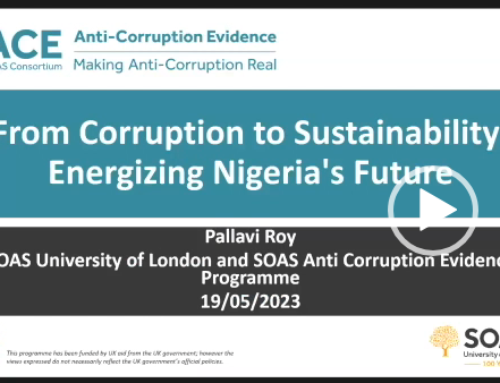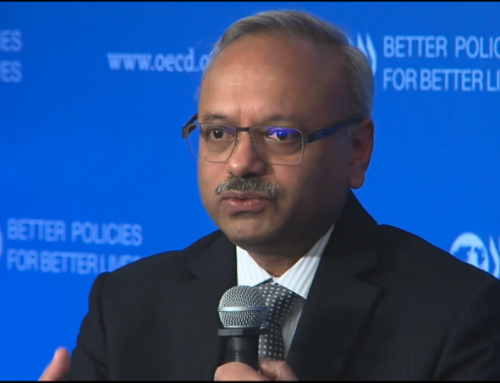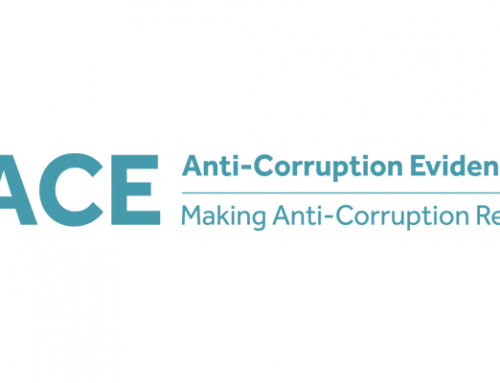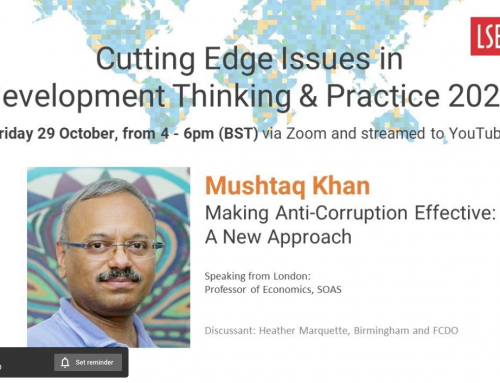This blog was written by Dr Pallavi Roy, Research Director of the SOAS Anti-Corruption Evidence Consortium. It was originally published on Columbia Center on Sustainable Investment on 15 June 2021. It is republished here under a Creative Commons licence.
Existing transparency-based anti-corruption approaches fail when interest in implementing is low
Following and enforcing “the formal rules” is not always a priority
Too often conventional anti-corruption approaches tend to view corruption as an individual choice that can be changed by targeting the individual’s costs and, sometimes, benefits. Hence the notion that harsh punishments or increased salaries will induce people to stop being corrupt. Linked to this is the idea that transparency reforms (better reporting standards, digitizing reporting, open data, etc.) will detect these instances of rule violation by individuals, ensure punishment, and lead to better governance. The underlying principle here is that transparency-linked detection of corruption in formal institutions, like the various arms of public administration or ministries, will lead to levels of public outrage that will make the punishment successful. In other words, transparency and demand for anti-corruption is the suitable antidote to governance transgressions. But, the political realities of developing countries suggest a very different outcome from anti-corruption thus designed. The first reality is that developing countries have high degrees of informality. Linked to this is the second reality: rules aren’t always imposed and enforced by legal, formal organs of the state like the police or the judiciary. They are instead enforced by informal mechanisms like social sanctions, political networks, or even mafia-like organizations.
However, what does this mean in everyday life? Readers having experience with developing countries might recognise this situation: despite free digital submission of forms for a public service, citizens who are not especially digitally literate are forced to use an agency that will submit forms on their behalf and charge them. Often, such agencies will be owned by politically connected persons who are “allowed” to make money this way. Or, such readers will remember the land transaction that took place not through the market mechanism, but because the land mafia intervened. Hence individuals or organizations ignore rules because of persistent violation by others, making it difficult for them to be rule-following. In our examples above, the political leader running the registration agency or members of the land mafia encounter few problems with enforcing their writ. For the citizen going about her everyday business, the reality is different. She might not want to use mafia connections, but it is the only way she can transact, even if she has all the relevant documents for the transactions, like registration deeds etc. As a result, the general enforcement of a rule of law (where formal law is impartially enforced) is not easy to achieve. What we get instead is a rule by law where enforcement is inconsistent, selective, and certainly not impartial. The difference in developed countries is that the economy is structured such that the majority of organizations are productive and relatively powerful enough to want rules to be consistently and effectively enforced. Of course, political networks and criminal syndicates are features in these settings too. But, relatively very few transactions go through such networks.
Those benefiting from the status quo can hinder progress on transparency and expected data uses
Given the developing country reality described above, there is little incentive on the part of powerful members of society to respond to anti-corruption reforms. And, because they are politically powerful and able to protect their selective interests (continuing to run superfluous agencies like the hypothetical one above or mafia-run operations), demands from citizens for effective anti-corruption also tend to be less successful.
Conventional anti-corruption approaches, including demands for transparency, make at least two assumptions that may not always hold true: 1) that once demands for transparency are made violations will be exposed; and 2) that this will result in improved outcomes because of greater accountability. However, this rarely happens in practice—in part because the imagined “improved outcomes” from reducing corruption fail to account for the interests of those actually benefiting in some way from systemic corruption. Successful and sustained anti-corruption requires organizations to either voluntarily enforce transparency requirements themselves or to call on others to do so on their behalf (horizontal or peer enforcement by those who were violating existing rules). Since transparency reform is a key element in the anti-corruption policy portfolio, demands for data and implementation of good practice based on this data are unlikely to be met when powerful elites can effectively undermine or block this. Implementation of transparency requirements or responsiveness to data requests will only happen when action based on the data provided is in the interests of at least some potentially productive and relatively powerful actors. For this reason, transparency reforms, including data-driven strategies, are a challenge to implement in developing countries.
Corruption in the EI sector is especially challenging and characterised by a hierarchy of benefits where rent capture occurs across all sections of society, from high level politicians to lower level managers and functionaries of oil companies, to those involved in marketing and distribution. A good example of the effects of this on anti-corruption is Nigeria’s Excess Crude Account (ECA)–Nigeria’s oil sales-related sovereign wealth fund. Even when some data in this case is available, outcomes remain unsatisfactory because the critical data for identifying corruption, like data on how the funds are used, isn’t provided. This is because the two apex bodies involved in decision making and implementation, the Nigerian National Petroleum Corporation and Nigerian Assembly (NASS), have almost no public accountability or interest in pursuing this. Moreover, they face no consequence or disincentive for not providing the data that could potentially reveal misuse and corruption. Hence it’s unsurprising that attempts for [adequate] disclosure from these organizations are usually unsuccessful.
The need for a new way of thinking about data in the context of anti-corruption
Putting the political economy problem, and not the data, in the driver’s seat
Our research in SOAS-ACE points to a pathway where transparency efforts are squarely driven by a more specific understanding of data use and data users. The first step is not about identifying the data needs, but instead, focuses on the political economy problem to be solved. Here, data transparency is not the sole solution. On the contrary, the data becomes relevant when devising solutions. Therefore ,at this stage, three questions need to be asked:
1) What is the type of data that we need?
2) Who will this be used by?
3) Do they have the incentive to use the data for productive change?
This approach can help us distinguish parts of the extractives value chain to identify pockets where rule-following behaviour can be supported with appropriate strategies.
Our scoping of micro-level effects of oil sector corruption—mainly through the artisanal oil industry (AOI) which is the theft of crude for further sale or local illicit refining—in the Niger Delta in Nigeria suggests that traditional transparency-based approaches that expose “bad” practices and negative outcomes to inspire action for redress do not work when those meant to demand redress are benefiting in some way from the status quo. Here, in theory, exposing the levels of pollution from AOI that produce products like diesel and petrol should make it unpopular among local communities and result in demands for shutting down the informal industry. But, this is far from the reality. Why? Because many of those suffering the effects of AOI’s pollution are also reaping benefits from it, thereby creating an interest in maintaining the status quo. AOI sites provide opportunities for work—directly at the sites and indirectly via activities like catering services for workers—where without these there would be very few jobs. The community also needs electricity, which is in short supply in Nigeria, and these sites provide them ready access to fuel for electricity.
On their own and cumulatively, these effects produce compelling reasons for community support for AOI, despite its apparent downsides to outsiders. This is called networked corruption—where every member of the community is ‘free riding’ on the oil theft (because they benefit from it) and, thus, has little incentive to push for change. Attempts to create coalitions needed to redress corruption in such a context will be challenging. An alternative policy agenda to attempt eradicating this form of corruption would be to instead focus on mitigating the harmful effects of AOI while simultaneously providing other livelihood opportunities to ensure the policy design has a chance of being impactful while being pro-poor. Therefore, the appropriate “anti-corruption” response here might be to work on mitigating externalities that hurt the vulnerable—namely children, youth, and women—by encouraging solar power generation and exploring productive livelihood opportunities as alternatives, rather than the more traditional approach of criminalizing or eliminating the activities of the sector as a whole. Thus, this approach focuses not on revealing and reducing corruption but instead on mitigating some of the negative consequences of corruption when anti-corruption is not feasible in the short-term, but its effects are exponentially damaging.
A more bottom-up and functional approach to transparency
Most Extractive Industry (EI) transparency measures reflect the advocacy agendas of international CSOs from the Global North and many of these have opposed AOI, with good reason sometimes. Yet, more politically located data can help identify the interests of EI affected communities, interests that can sometimes be at odds with those of international CSOs. So, how might more bottom-up transparency of data be deployed more impactfully in the context of AOI in the Niger Delta? It would start by understanding AOI in a localized political context. One innovative method would be to devise a social accounting matrix (SAM) for each community to establish the nature and extent of those benefiting from AOI in order to understand the functional role and relative importance of AOI in people’s lives. A SAM is essentially a record of transactions between individuals and organizations and helps construct the GDP of an economy. But, when used at the community level it could provide a snapshot of the local artisanal economy and provide a database of jobs directly and indirectly linked to AOI. Our research has collected this data which we hope to translate into a local SAM. This type of data could provide a sense of the income requirements needed to induce people to leave AOI and help design alternative employment opportunities for at least some of those currently helping to keep the heavily-polluting and otherwise problematic AOI in place.
This method of designing measures to improve governance through incremental sub-sectoral changes addressing the consequences of corruption can be used in a complementary manner with accountability demands that use data to address the sources of corruption. For instance, international CSOs could look at funds spent on amnesty programmes run by the government used to rehabilitate Niger Delta militants. This could then be compared to the costs to fund better livelihood programmes for AOI communities to aid donors in their decisions about the relative impacts and value for money. This way, donors could continue to make effective use of the substantial investments already made in accountability efforts.
An alternative approach to transparency and anti-corruption
Our research in SOAS-ACE devises solutions keeping these pathways front and centre and our work in the Niger Delta is one example. The alternative approach incorporates two key premises: 1) rule violations are widespread in developing countries for reasons described above; and 2) demanding transparency in a context where those in a position to deliver it have little incentive to comply is unlikely to increase accountability. We look for solutions that improve delivery of services, say in healthcare by decreasing absenteeism in primary health care centres, or that help improve productivity in a targeted sector, like improving electricity generation in less expensive and more environmentally sustainable ways. This is possible either by devising a new set of rules that can actually be enforced or by creating incentives that allow these rules to be enforced. This is the so-called “supply side” that complements policy that enables building capacity for mobilizing and organizing demand for anti-corruption. To draw it back to what we began with, in at least some contexts this helps ensure that those who were once breaking rules no longer see rule breaking in their interest because they can remain profitable without resorting to corruption. A sort of business case for anti-corruption if you will!






